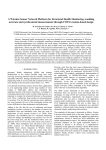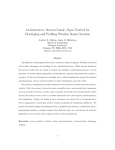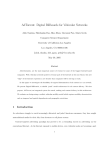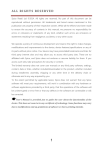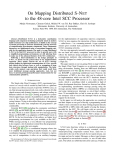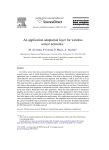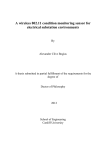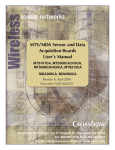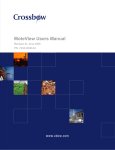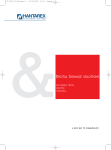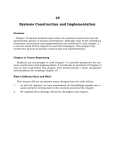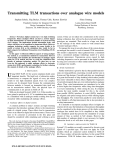Download A Distributed Power Control and Routing Scheme for Rechargeable
Transcript
A Distributed Power Control and Routing Scheme
for Rechargeable Sensor Networks
Amitangshu Pal, Bonee Soibam and Asis Nasipuri
Electrical & Computer Engineering, The University of North Carolina at Charlotte, Charlotte, NC 28223-0001
E-mail:{apal,bsoibam,anasipur}@uncc.edu
Abstract- We propose a joint power control and quality
aware routing scheme for rechargeable wireless sensor
networks (WSNs) that are characterized by a high degree
of spatial and temporal variations of energy resources.
The proposed scheme adapts the energy consumption in
the nodes to meet their corresponding energy resources
with the objective of attaining network wide reliability
of operations. This is achieved by dynamically controlling
the transmission powers and route selection. Some initial
performance evaluations are presented from experimental
studies to show the effectiveness of the proposed scheme.
Keywords: Wireless sensor networks, power controlled
routing, distributed algorithms.
I. I NTRODUCTION
Wireless sensor nodes are equipped with an integrated low
power processor, memory and a radio that are dependent on
its local energy supply. Since batteries are difficult to replace,
the popular approach for achieving long term operations in
wireless sensor networks (WSNs) is by utilizing harvested
energy from renewable resources, such as solar. However, renewable energy can have wide spatial and temporal variations
due to natural (e.g. weather) and location specific factors (e.g.
exposure to sunlight) that can be difficult to predict prior
to deployment. Consequently, rechargeable wireless sensor
networks must have mechanisms to dynamically adapt their
energy consumption based on estimated energy resources.
Transmission power control has been widely researched
in the wireless community [1], [2]. The objectives of these
schemes are mainly twofold: First, reducing transmit power
reduces energy consumption on the sending node. Second, interference is reduced significantly by reducing transmit power.
However, in low power wireless sensor nodes, the amount
of energy consumed for transmissions is generally smaller
than that consumed for receiving. In particular, in large scale
WSNs that do not use transmission scheduling due to difficulties in achieving tight network-wide time synchronization,
overhearing is the dominating factor that affects its energy
consumption [3], [4]. Moreover, when the packet size and the
packet transmission rates are small, interference is usually not
a primary performance factor. The objective of the current
work is apply transmit power control and route adaptations for
controlling the energy consumed from overhearing. The main
challenge is that the degree of overhearing at a node depends
on the transmit power levels and traffic of its neighbors.
Consequently, effective overhearing control requires network
wide adaptations as opposed to independent adaptations at the
nodes.
A significant amount of work has been reported on power
control for WSNs. In [5], [6] the authors propose power
control schemes that use feedback control to set the transmit
power of a link to minimum level to achieve a required link
quality. Unfortunately, these schemes do not address power
control based on node specific requirements, which is a key
objective of our work. Also, all these above schemes propose
power control for a specific link. But power control is tied
with routing as changing the link quality of a link results in
changes in route selection. Thus the power control problem
should be considered jointly with routing, which is one of the
contributions of this work.
The rest of the paper is organized as follows. In section
II, we summarize the motivations and objectives behind our
work. Section III describes our proposed distributed power
control scheme for WSNs. Some experimental results of our
proposed scheme are discussed in section IV. We conclude our
paper section V.
II. M OTIVATION AND O BJECTIVES
Development of effective solutions for energy harvesting
from renewable resources is gaining increasing importance
for achieving long term reliable operations of wireless sensor
networks. This includes energy from sunlight, vibrations, heat,
magnetic field, and others. All these sources produce spatial
and temporal variations. In this paper we mainly focus on solar
energy harvesting. A large scale WSN may comprise many
sensor nodes placed somewhat randomly geographically, e.g.
for environmental or structural monitoring applications. Random node placement may locate some nodes in shadows and
others in extended sunlight. Nodes have different orientations,
affecting the irradiance collected by the solar panels. Changes
of weather and sun orientation also change solar power intake
over time. This paper proposes a technique for adapting the
transmit power levels as well as route selection to address
these spatio-temporal characteristics in rechargeable wireless
sensor networks. To study the nature of this spatio-temporal
variations, we deploy an experimental testbed using a set if
MICAz motes with irradiance sensors on the rooftop of our
department building and collect irradiance data over a period
of few months. Fig 1 shows the irradiance values of three
11th October
800
600
400
200
0
0:00:35
11th October
800
600
400
30th October
800
600
400
200
0
0:00:35
8:09:02 12:13:19 16:46:56 20:52:53 23:57:48
Time
11th October
1000
30th October
200
4:04:49
5th October
5th October
1000
30th October
Irradiance (Watt/meter2)
Irradiance (Watt/meter2)
1000
1200
1200
5th October
Irradiance (Watt/meter2)
1200
4:04:49
(a)
8:09:02 12:13:19 16:46:56 20:52:53 23:57:48
Time
(b)
0
0
50
100
150
200
Time
250
300
350
(c)
Fig. 1. Irradiance measurement of (a) node 153 (b) node 155 and (c) node 159 for two sunny days (5th and 11th October, 2012) and a cloudy day (30th
October, 2012). Node 159 is kept in the shaded region, whereas 153 and 155 gets sunlight most of the time.
from all nodes to the sink. All nodes use an extremely low
transmit power of −28.5 dBm and apply the LowPowerListening scheme [9] with a wake-up interval of 125 milliseconds.
We run this experiment for 10 minutes and record the total
number of beacons and data packets sent/received throughout
the network as well as the network wide overhearing. The
results, shown in Figure 2(b), indicate that even with sleep
cycles, overhearing is a dominating factor in the energy
consumption in the nodes. In our previous works [10], [11]
we developed a mechanism to distribute the network traffic
over multiple channels which led to reduction in overhearing
and significant improvement in the lifetime of the network. In
this work we propose the scheme of cooperative power control
to reduce overhearing on the nodes that are critical in terms
of remaining battery capacities.
Thus the objective of designing the power control and
routing scheme is to adapt the energy consumption in the
nodes by controlling the corresponding overhearing traffic as
determined by network traffic in their neighborhoods. In the
absence of such adaption, nodes that are in the shadowed
region will deplete all their energy faster, which can result
in unbalanced lifetimes of the nodes. This paper addresses
a distributed collection tree based power control and routing
scheme where each node controls its transmit power based
on amount of energy-intakes, battery remaining capacities and
usages of its own as well as in its neighborhood.
2000
Sink
Overhearing
1500
Data trans
1000
Beacon recv
500
Data recv
Beacon sent
0
(a)
(b)
Fig. 2. Experimental setup (a) to assess the activities of the radio (b) of a
wireless sensor node performing data collection.
motes in three different days, illustrating high variations in
the amount of irradiance over both time and space.
Radio transmissions as well as receptions are the critical
energy-consuming tasks in typical low-powered wireless sensor nodes. For instance, the MICAz nodes draw about 20mA
of current while transmitting and receiving, whereas it draws
about 20 µA in idle mode and 1µA in sleep mode. Hence, a
key aspect of designing energy-efficient wireless sensor nodes
is to minimize the radio active periods, allowing the node to
sleep as long as possible. Popular energy efficient wireless
sensor networking protocols such as XM esh [7] employs lowpower (LP) operation by letting nodes duty cycle in their sleep
modes for brief periods of time to detect possible radio activity
and wake up when needed. While this principle extends the
battery life (lifetime) of the nodes considerably, a key factor
that leads to energy wastage is overhearing, i.e. receiving
packets that are intended for other nodes in the neighborhood.
The traditional mechanism used for avoiding overhearing is
transmission scheduling, which requires time synchronization
that we assume is absent in the WSNs.
The effect of overhearing is illustrated in Figure 2, which
depicts an experiment using six MICAz motes and a sink.
The network is programmed with the collection tree protocol
(CTP) [8] application where each node transmits periodic data
packets comprising of sensor observations with an interval of
10 seconds and routing packets (beacons) with an interval that
varies between 128 and 512000 milliseconds. The network
uses the beacons to build link quality based least-cost routes
III. P OWER -C ONTROLLED ROUTING IN WSN S
We consider a data collecting wireless sensor network
where nodes follow a tree structure to forward data to the sink.
In these kind of networks, a node overhears all nodes that are
in the receiving range of that node. Also based on different
forwarding and overhearing rates, the rate of battery drainings
are also different. In this paper we assume that the amount
of harvesting energy intake is reflected in the nodes battery
voltages, which we use to calculate the battery health condition
as explained later. In our power control scheme, if a node has
lesser battery health compared to its neighbors, the neighbors
cooperatively reduce power to reduce overhearing on that node
keeping the link quality within a reasonable range. This power
2
to one of the collection root nodes in the network. At the
start of the network some of the nodes advertise themselves
as the root nodes or sink nodes. The rest of the nodes use the
root advertisements to connect to the collection tree. When a
node collects any physical parameter, it is sent up the tree.
As there can be multiple root nodes in the network, the
data is delivered to one with the minimum cost. CTP is an
address free protocol, so a node does not send the packet to
a particular node but chooses its next hop based on a routing
gradient. CTP uses ETX as its routing gradient as mentioned
earlier. The sink always broadcasts an ETX = 0. Each node
calculates its ETX as the ETX of its parent plus the ETX
of its link to the parent. This measure assumes that nodes
use link-level acknowledgements and retransmissions. A node
i chooses node j as its parent among all its neighbors if
ETXij +ETX of j < ETXik +ETX of k ∀k 6= j, where ETXij
and ETXik are the ETX of link i→j and i→k respectively.
In this process a node chooses the route with the lowest ETX
value to the sink.
controlling scheme may result a node to change its route that
helps its neighbor that is of lesser battery health.
A. Preliminaries
We define the battery health-metric H of a node to represent
its remaining battery lifetime, i.e. the estimated time until its
battery is depleted under its currently estimated energy usage.
We assume H∝ B
I , where B is the remaining capacity of the
battery and I represents the estimated current drawn at the
node. Based on the experimentally validated model [12], the
current drawn in each node is calculated as follows:
I
TBr
+ M.IDt TDt + N. IBrTB
+ O.IDr TDr
=
IBt TBt
TB
+
F.IDt TDt +
Is Ts
TD
+ NP .IP TP
(1)
where Ix and Tx represent the current drawn and the duration, respectively, of the event x; and TB represents the
beacon interval. Transmission/reception of beacons is denoted
by Bt /Br , data transmit/receive is denoted by Dt /Dr and
processing and sensing are denoted as P and S, respectively. O
and F are the overhearing and forwarding rates, respectively,
and N is the number of neighbors. M is the rate at which a
node transmits its own packets. If there are no retransmissions,
then M = T1D , where TD is the data interval. NP represents
the number of times that a node wakes per second to check
whether the channel is busy, and is set to 8 in our application. We assume that each node is able to estimate all the
dynamic parameters that are used in equation (1), by periodic
assessment of its overheard and forwarded traffic.
The battery capacity B (energy resource) depends on a
number of factors that include the solar irradiance, the efficiency of the solar panel, the efficiency of the converter
circuit, as well as physical and environmental factors such
as temperature and state of health of the battery or storage
element. An appropriate model for estimating the battery state
of charge is currently being developed by the researchers,
and will be included in future work. For the development
and evaluation of the power control and routing scheme for
adapting the energy consumpiton at the nodes to their battery
health, we assume that the battery capacity is obtanied from
battery voltage. To further simplify the task of estimating B,
we apply a linear relationship between the battery voltage and
B, which is explained later.1
To estimate the quality of a route, we use the expected
number of transmissions (ETX) that is used in Collection
Tree Protocol (CTP) which is discussed later. An ETX is the
expected number of transmission attempts required to deliver
a packet successfully to the receiver. Hence, a low ETX value
indicates a good end to end quality of a route, and vice versa.
In our scheme, ETX is calculated similar to [8].
C. The Proposed Cooperative Power Control Scheme
We now present the proposed power control and routing
scheme for WSNs that mainly tries to reduce overhearing
on critical nodes, which are nodes that have battery health
lower than average. This will extend the overall lifetime of
the network. All nodes periodically determine their parents
as well as transmit powers based on their neighboring link
qualities and their neighbors health metrics. We assume that
all nodes broadcast periodic beacon messages, which include
their node ID, ETX value and a field named critical node
(CN) which is 1 if a node is critical and 0 otherwise. Also
the beacon message carries another field named probability of
control (POC) which is explained later.
We define a node as critical node if its H < α.µH , where
µH is the mean of its neighbors health metrics. It then makes
. Otherwise, the node is considered as good
the POC = µHµ−H
H
node and POC = 0 for all good nodes. The parameter POC
is mainly used by a critical node to inform its neighbors how
critical the node is. If a node’s condition is very critical, it
broadcasts a high POC. So its neighbors reduce their transmit
power with high probability. The reverse happens when a node
is less critical.
If a node is not in a critical stage, it broadcasts beacons
with CN = 1 and everything works same as CTP. The parent
is selected as the neighbor with lowest ETX and is done
periodically. The power adaptation does not take place in this
case.
When a node becomes critical, it broadcasts its beacon
message with CN = 1. Nodes that receive a beacon with CN
= 1 reduce their power by β with probability POC that is
sent by the critical node, if its link-ETX is less than some
threshold ETXm and its current transmit power is more than
a minimum level. Link-ETX of a node is defined as the ETX
of the link between that node and its parent. If it receives
beacon messages from multiple critical nodes, the power is
reduced with probability equal to the maximum of all POCs
B. Collection Tree Protocol (CTP)
CTP is a tree based collection protocol whose main objective is to provide best effort anycast datagram communication
1 Note that the battery voltage does not accurately reflect its state of charge,
however, it is a simple way to obtain an approximate measure of the level of
charge in a battery.
3
respectively, α and β are assumed to be 0.5 and 1 respectively.
The beacon and DATA transmission interval are 10 and 15
seconds respectively. Parents are selected in every 1 minute.
The power adaptation interval is assumed to be 5 minutes.
In our experiment, all nodes send their transmit power, ETX
and the number of packets overheard in the last 1 minute in
their DATA packets to the sink. These parameters are recorded
and monitored in a laptop that is connected to the sink to be
analyzed later. Parameters used for experiments are listed in
Table I.
of the critical nodes. This results in reduced overhearing on the
critical nodes. Also if the link-ETX of any node goes beyond a
threshold ETXM , nodes start increasing power in steps of β. In
this scheme the change in transmit power affects ETX which
results in change in routes. Thus the joint power control and
routing is achieved that tries to avoid overhearing traffics on
critical nodes. The pseudocode for our power control scheme
is depicted in Algorithm 1.
Algorithm 1
Power control scheme for any node i
1:
2:
3:
4:
5:
6:
7:
8:
9:
CNi = 1, if i is a critical node and 0 otherwise
Xi = 1, if i is a neighbor of a critical node and 0 otherwise
poweri = current transmit power of node i
linkETXi = ETX of the link between node i and its parent
Pm , PM = Minimum and maximum transmit power
if linkETXi > ETXM && poweri ≤ PM − β then
poweri = poweri + β
else
if Xi == 1 && CNi 6= 1 && linkETXi < ETXm && poweri ≥ Pm + β
then
10:
poweri = poweri - β with probability = maximum POCs of all critical nodes
11:
end if
12: end if
TABLE I
PARAMETERS USED
Var
IBt
IDt
IP
Values
20 mA
20 mA
8 mA
Var
TBt
TDt
TP
Values
140 ms
140 ms
3 ms
Var
IBr
IDr
IS
Values
20 mA
20 mA
7.5 mA
Var
TBr
TDr
TS
Values
140 ms
140 ms
112 ms
For the purpose of this work, we estimate battery capacity B
from the battery voltage. MICAz motes operates in a voltage
range of 2.7V to 3.3V. The actual battery voltage is related
1.223×1024
to the ADC reading as follows: Vbat = ADC
reading [13].
Assuming that the battery capacity changes linearly from
0% at 2.6V (battery sensor = 482 ADC units) to 100% at
3V (battery sensor = 417 ADC units), we can estimate the
capacity for any given ADC reading x to be 482−x
0.65 . Since
batteries can actually have voltages exceeding its peak rating,
we set all voltages above 3V to reflect a capacity of 100%.
Hence, we model battery capacity B = min 100, 482−x
0.65 .
Note that estimation of battery capacity from the voltage is
not accurate; however it provides a computationally simple
method for evaluating the performance of our power control
and routing scheme experimentally.
In our experimental setup we place the sensor nodes in a
layout similar to Fig 3. All nodes are initially at 100% capacity.
After 25 minutes the capacity of a node is manually changed
to 50% by reducing its battery voltage (using a variable power
source) so that it becomes a critical node. Fig 3 shows one
instance of the data gathering tree of our network before and
after changing the capacity of the critical node. This figure
shows that when all nodes are in good state of battery, all of
them directly send their traffics to the sink as all of them are
in their highest power level. Later on when a critical node
comes in picture, nodes started reducing their transmit power
and start multi-hopping to forward packets to the sink.
Fig 4 shows the variation of overhearing with time for the
critical node which clearly shows the reduction in overhearing
on the critical node after 25 minutes. This is because of
the fact that other neighboring nodes started reducing their
transmit power to avoid overhear the critical node. Fig 5 shows
the transmit power and ETX of a neighboring node of the
critical node. This figure shows that the transmit power started
reducing after 25 minutes and also the change in ETX is clear
with the change in transmit power. Due to the restriction of the
maximum ETX threshold, the transmit power starts oscillating
when it reaches below this maximum threshold. This short
D. Discussion
Our proposed power controlled routing scheme takes into
account a number of factors that are explained as follows:
Battery state of individual nodes: The battery state of any
node is taken into account by using the term B. If the battery
condition of any node is bad, its health metric decreases. When
it becomes a critical node, its neighbors reduce power with
some probability which tries to reduce overhearing on that
critical node.
Reduced load and overhearing on critical nodes: The term
I calculates the average current consumption of a node. Thus,
if a node becomes a critical node due to over-usage, its health
metric decreases. So that nodes in its neighborhood reduces
power with some probability.
Route quality: Also the ETX quantifies how good a route
is. The route quality is important as bad routes result in more
retransmissions which reduce the network lifetime.
The proposed scheme does not incur any additional control
overhead other than periodic beacon updates. Also to avoid
idle listening, nodes use low-power listening [9] where they
sleep most of the time and wakes up in a periodic interval. If
they sense the channel to be busy, they remain on. Otherwise,
they go back to sleep to conserve energy. Problems such as
routing loop detection and repairing are tackled similar to CTP.
IV. P ERFORMANCE E VALUATION
This section presents evaluation results of our power control
scheme from experiments on a real testbed. We first demonstrate that our proposed power control scheme effectively
reduces overhearing on critical nodes using an experimental
testbed comprising of 13 MICAz motes consists of a sink in
an area of 12 × 9 meters2 . The transmit power can be varied
in between -13 dBm (corresponds to the power level of 9 for
MICAZ motes) and -28.5 dBm (corresponding power level
is 2). Also ETXM and ETXm are assumed to be 3 and 2.5
4
Power
ETX
10
9
8
7
6
5
4
3
2
1
0
Sink
Sink
Sink
Sink
(a)
(b)
Fig. 3. An instance of our networkTime
topology (a) before and (b) after changing the battery capacity of the critical node. The red node is made to be a
critical node after 25 minutes.
70
Transmit Power Level
Overhearing
60
ETX
10
9
8
7
6
5
4
3
2
1
0
50
40
30
20
10
0
Time
Time
70
Fig. 5. Transmit
power and ETX of a neighbor (shown in green in Fig 3)
60 node.
of the critical
Overhearing
Fig. 4. Overhearing of the critical node (shown in green in Fig 3). The
x-axis is showing the number of packets overheard in the last 1 minute.
experiment clearly shows the effectiveness of our proposed
scheme in reducing overhearing on the critical node.
50
40
future considerations.
These extensions can make our scheme
30
more suitable
for
large
and dense WSNs in practice.
20
10
ACKNOWLEDGEMENT
This work was supported by NSF grant CNS-1117790.
V. C ONCLUSIONS AND F UTURE W ORK
0
In this paper, we propose a distributed scheme for controlling transmit power in a data gathering rechargeable wireless
sensor networks for maximizing the network lifetime. Through
experiments, we demonstrate that our proposed scheme significantly reduces overhearing on the critical nodes. The proposed
scheme has no additional overhead other than periodic beacon
updates, which makes it suitable for implementations in reallife applications to prolong the network lifetime.
In future we plan to extend our proposed power control
scheme in several directions. First, we will implement an
accurate model for estimating the battery state of charge.
This is being developed from extensive experimentation and
modeling of different battery technologies. In addition, we are
researching models for solar irradiance predictions to obtain
more realistic assessment of energy variations. Third, currently
our scheme controls power when it finds a critical node. Even
if there are no critical node, sometimes transmit power can
be controlled without sacrificing the network quality which is
one of our future considerations. Fourth, as shown in Fig 5,
for some nodes the transmit power as well as ETX oscillates
which can result in packet drops and retransmissions. Thus
an approach to dampen these oscillations will improve the
network performance. Also simulating and experimenting our
scheme in larger network scenarios will give more insights
about the performances and tradeoffs which is one of our
R EFERENCES
Time
[1] T. A. ElBatt, S. V. Krishnamurthy, D. Connors, and S. K. Dao, “Power
management for throughput enhancement in wireless ad-hoc networks,”
in ICC (3), 2000, pp. 1506–1513.
[2] G. J. Foschini and Z. Miljanic, “A simple distributed autonomous power
control algorithm and its convergence,” IEEE Transactions on Vehicular
Technology, vol. 42, no. 4, pp. 641–646, 1993.
[3] P. Basu and J. Redi, “Effect of overhearing transmissions on energy
efficiency in dense sensor networks,” in IPSN, 2004, pp. 196–204.
[4] W. Ye, J. S. Heidemann, and D. Estrin, “An energy-efficient mac protocol
for wireless sensor networks,” in INFOCOM, 2002.
[5] S. Lin, J. Zhang, G. Zhou, L. Gu, J. A. Stankovic, and T. He, “ATPC:
adaptive transmission power control for wireless sensor networks,” in
SenSys, 2006, pp. 223–236.
[6] Y. Fu, M. Sha, G. Hackmann, and C. Lu, “Practical control of transmission power for wireless sensor networks,” in ICNP, 2012.
[7] “Xmesh
user
manual,
Crossbow
technology,”
http://www.xbow.com/Products, 2007.
[8] O. Gnawali, R. Fonseca, K. Jamieson, D. Moss, and P. Levis, “Collection
tree protocol,” in SenSys, 2009, pp. 1–14.
[9] D. Moss, J. Hui, and K. Klues, “Low Power Listening, Core Working
Group, TEP 105.”
[10] A. Pal and A. Nasipuri, “A distributed channel selection scheme for
multi-channel wireless sensor networks,” in MobiHoc, 2012, pp. 263–
264.
[11] ——, “DRCS: A distributed routing and channel selection scheme for
multi-channel wireless sensor networks,” in IEEE PerSeNS, 2013, pp.
602–608.
[12] A. Nasipuri, R. Cox, J. Conrad, L. V. der Zel, B. Rodriguez, and
R. McKosky, “Design considerations for a large-scale wireless sensor
network for substation monitoring,” in LCN, 2010, pp. 866–873.
[13] “MIB/MPR user manual,” http://www.xbow.com.
5






